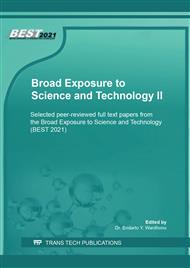[1]
C. Balagna, S. Spriano, M.G. Faga, Characterization of Co-Cr-Mo alloys after a thermal treatment for high wear resistance, Mater. Sci. Eng. 32 (2012) 1868-77.
DOI: 10.1016/j.msec.2012.05.003
Google Scholar
[2]
A.J. Aminatun, T. Saktiani, Optimalisasi Sifat Mekkanik Paduan Kobalt Sebagai Implan Tulang Prosthesis Melalui Proses Sintering, Malang, (2013).
Google Scholar
[3]
A. Alfirano, S. Mineta, S. Namba, T. Yoneda, K. Ueda and T. Narushima, Heat treatment of ASTM F75 Co-Cr-Mo-C-Si-Mn alloys, Mater. Sci. Forum. 654-656 (2010) 2180-3.
DOI: 10.4028/www.scientific.net/msf.654-656.2180
Google Scholar
[4]
Y. Chen, Y. Li, S. Kurosu, K. Yamanaka, N. Tang, Y. Koizumi and A. Chiba, Effects of sigma phase and carbide on the wear behavior of CoCrMo alloys in Hanks' solution, Wear. 310 (2014) 51-62.
DOI: 10.1016/j.wear.2013.12.010
Google Scholar
[5]
Q. Wang, C. Huang, L. Zhang, Microstructure and tribological properties of plasma nitriding cast CoCrMo alloy, J. Mater. Sci. Technol. 28 (2012) 60-6.
DOI: 10.1016/s1005-0302(12)60024-3
Google Scholar
[6]
I. Campos-silva, M. Ortiz-dominguez, M. Elias-espinosa, R.C. Vega-morón, D. Bravo-bárcenas and U. Figueroa-lópez, The powder-pack nitriding process: growth kinetics of nitride layers on pure iron, J. Mater. Eng. Perform. 24 (2015) 3241-50.
DOI: 10.1007/s11665-015-1642-7
Google Scholar
[7]
A. Çelik, Ö. Bayrak, A. Alsaran, I. Kaymaz and A.F. Yetim, Effects of plasma nitriding on mechanical and tribological properties of CoCrMo alloy, Surf. Coatings Technol. 202 (2008) 2433-8.
DOI: 10.1016/j.surfcoat.2007.08.030
Google Scholar
[8]
Z. Werner, M. Barlak, M. Gradzka-Dahlke, R. Diduszko, W. Szymczyk, J. Dabrowski, J. Piekoszewski and K. Borkowska, The effect of ion implantation on the wear of Co-Cr-Mo alloy, Vacuum. 81 (2007) 1191-4.
DOI: 10.1016/j.vacuum.2007.01.014
Google Scholar
[9]
B. Bayrak, H. Kovaci, F. Yildiz, A.F. Yetim and A. Çelik, Dry sliding wear characteristics of plasma-nitrocarburized Co-Cr-Mo alloy, Met. Sci. Heat Treat. 58 (2017) 742-7.
DOI: 10.1007/s11041-017-0089-x
Google Scholar
[10]
N.I. Zainal Abidin, A.D. Atrens, D. Martin and A. Atrens, Corrosion of high purity Mg, Mg2Zn0.2Mn, ZE41 and AZ91 in Hank's solution at 37°C, Corros. Sci. 53 (2011) 3542-56.
DOI: 10.1016/j.corsci.2011.06.030
Google Scholar
[11]
I. Hidayah, The increased of lactic acid concentration in the blood after work indonesia, J. Occup. Saf. Heal. 7 (2018) 131.
Google Scholar
[12]
A. Candra, G. Rusip, Y. Machrina, The effect of aerobic exercise to lactic acid and borg scale football, J. MKMI. 12 (2016) 7-13.
Google Scholar
[13]
J.J. Heckman, R. Pinto, P.A. Savelyev, Pengaruh pemulihan aktif jogging terhadap penurunan asam laktat pada olahraga bulutangkis, J. Sport Area. (2019) 10-8.
DOI: 10.24114/so.v2i1.12873
Google Scholar
[14]
A.B. Setiawan, W. Purwadi, Pengaruh temperatur dan waktu proses nitridasi terhadap kekerasan permukaan FCD 700 dengan media nitridasi urea, Semin. Nas. Kluster Ris. Tek. Mesin. (2009) 35-40.
DOI: 10.31963/sinergi.v20i1.3474
Google Scholar
[15]
J.M. Claros, E. Nascimento, A.S. D'Oliveira, Effect of the oxide film on the sliding wear behavior of a CoCrMoSi alloy hardfacing coating, ABCM International Congress (2018) 1-8.
DOI: 10.26678/abcm.cobem2017.cob17-2328
Google Scholar
[16]
K. Ueda, K. Nakaie, S. Namba, T. Yoneda, K. Ishimizu and T. Narushima, Mass loss and ion elution of biomedical Co-Cr-Mo alloys during pin-on-disk wear tests, Mater. Trans. (2013) 1-7.
DOI: 10.2320/matertrans.me201316
Google Scholar
[17]
J.A. Ortega-saenz, M.A.L. Hernandez-rodriguez, V. Ventura-sobrevilla and R. Michalczewski, Tribological and corrosion testing of surface engineered surgical grade CoCrMo alloy, Wear. 271 (2011) 2125-31.
DOI: 10.1016/j.wear.2010.12.062
Google Scholar


